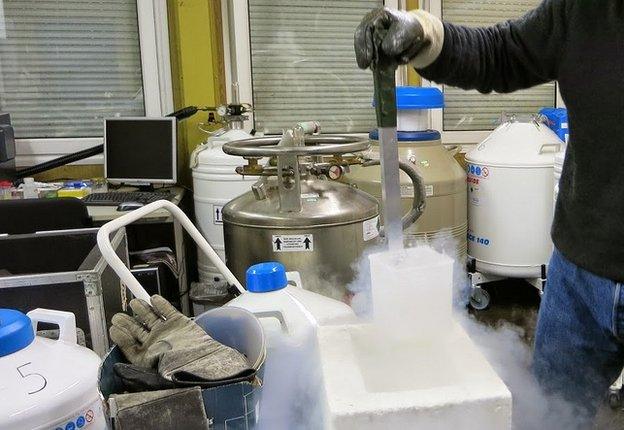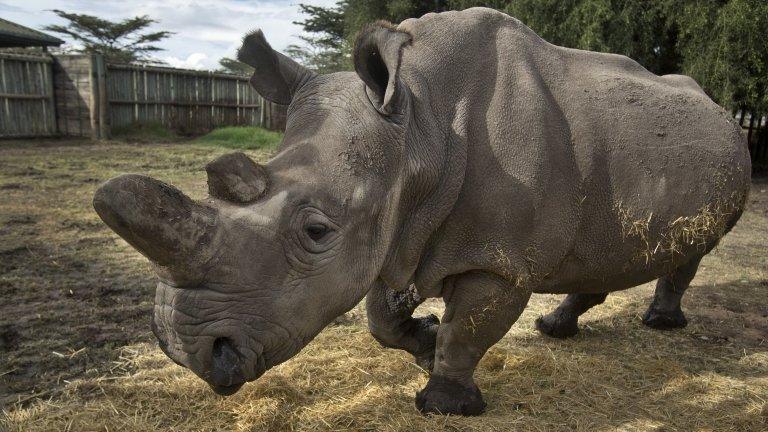First step in plan to save northern white rhino
- Published

Artificial insemination seems to be off the table as an option
Experts are pinning their hopes on in-vitro fertilisation (IVF) to save the northern white rhino from extinction.
Just five of the animals remain on the planet, after two adult males died within months of each other at the end of 2014.
At a meeting in Nairobi, Kenya, on Tuesday, conservationists decided to harvest eggs from the remaining females.
The eggs will be stored with a view to being used for IVF in the future.
While offering some hope for the rhino sub-species, it also underlines the dire prospects for the last animals.
The eggs will join frozen northern white rhino sperm already stored at an institute in Berlin, Germany.
Experts say IVF will only be attempted after techniques improve, but have set no expected timeframe for this.
After harvesting the oocytes (immature egg cells), experts will "wait for a time when the IVF techniques will be developed and tested enough to give us a reasonable chance that usage of (northern white rhino) samples would lead to a successful embryo transfer", said Jan Stejskal, from the Dvur Kralove zoo in the Czech Republic, which owns the last animals.
He told BBC News: "This still needs to be carefully discussed with the experts in the field, but in general we can say we decided to do a first step towards IVF."

Analysis
By David Shukman, Science Editor
The grim truth that few want to discuss too openly is that extinction is now the likeliest outcome for the northern white rhino.
The most successful conservation schemes with other animals have all involved larger bands of survivors.
Once the numbers dwindle into single figures there are fewer options, fewer chances of any kind of assisted reproduction and a greater risk of in-breeding.
For those involved in caring for the last five, these are painful times. At Dvur Kralove zoo in the Czech Republic, which owns the animals and houses one of them, a female called Nabire, the keepers are devoted to her, and she appears relaxed with them.
And this raises the question of how best to be humane: the sedations and interventions all carry risk. When we broadcast a story about the plight of the northern whites earlier this month, many people told me they believed the animals should be left in peace, that it was kinder for nature to take its course.
If that is the outcome it will make conservationists all the more determined to save other species under threat.

Many of the remaining animals are of advanced age, and by the time IVF becomes possible, scientists might have to implant an embryo in a surrogate female from the northern white's close relative, the southern white rhino.
Mr Stejskal said there was no current plan to use artificial insemination as a strategy. This had previously been a theoretical possibility for one of the animals, Naijin, which lives at the Ol Pejeta Conservancy in Kenya.

An institute in Berlin is one of those storing sperm from northern white rhino
2014 turned out to be an annus horribilis for the sub-species. On 17 October, a 34-year-old male called Suni died of a suspected heart attack at the Ol Pejeta Conservancy in Kenya.
Then, on 14 December, Angalifu, a 44-year-old male living at San Diego Zoo in the US also passed away.
The last remaining male is 43 years old - elderly by rhino standards - and is considered incapable of mating on his own.
Experts have already taken the first steps towards harvesting eggs from Nabire, a 31-year-old female living at the Dvur Kralove Zoo. But the procedure in October last year had to be stopped out of concern for the health of the animal. But the scientists could resume the effort at some point soon.
Follow me on Twitter, external.
- Published21 January 2015
- Published16 December 2014
